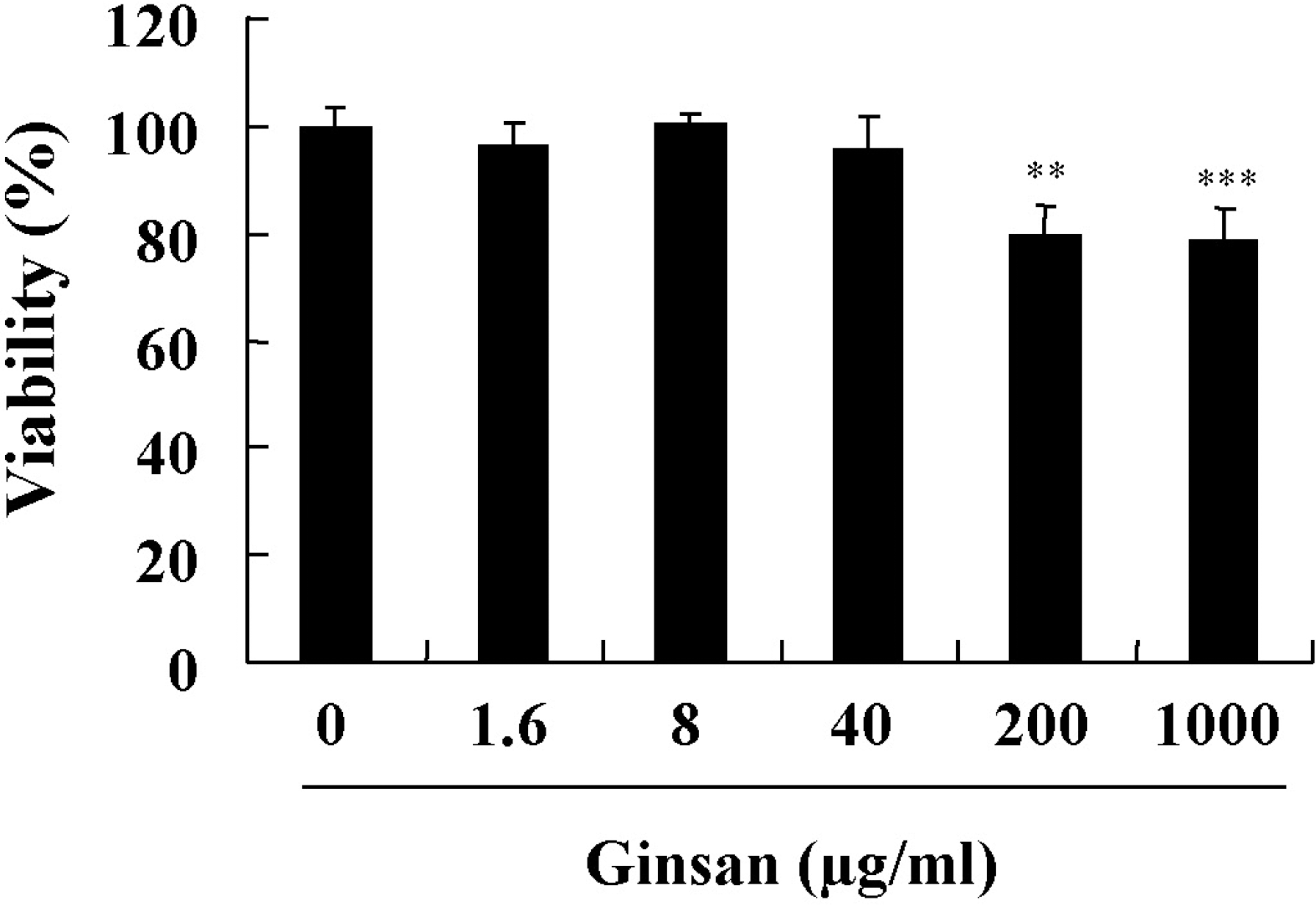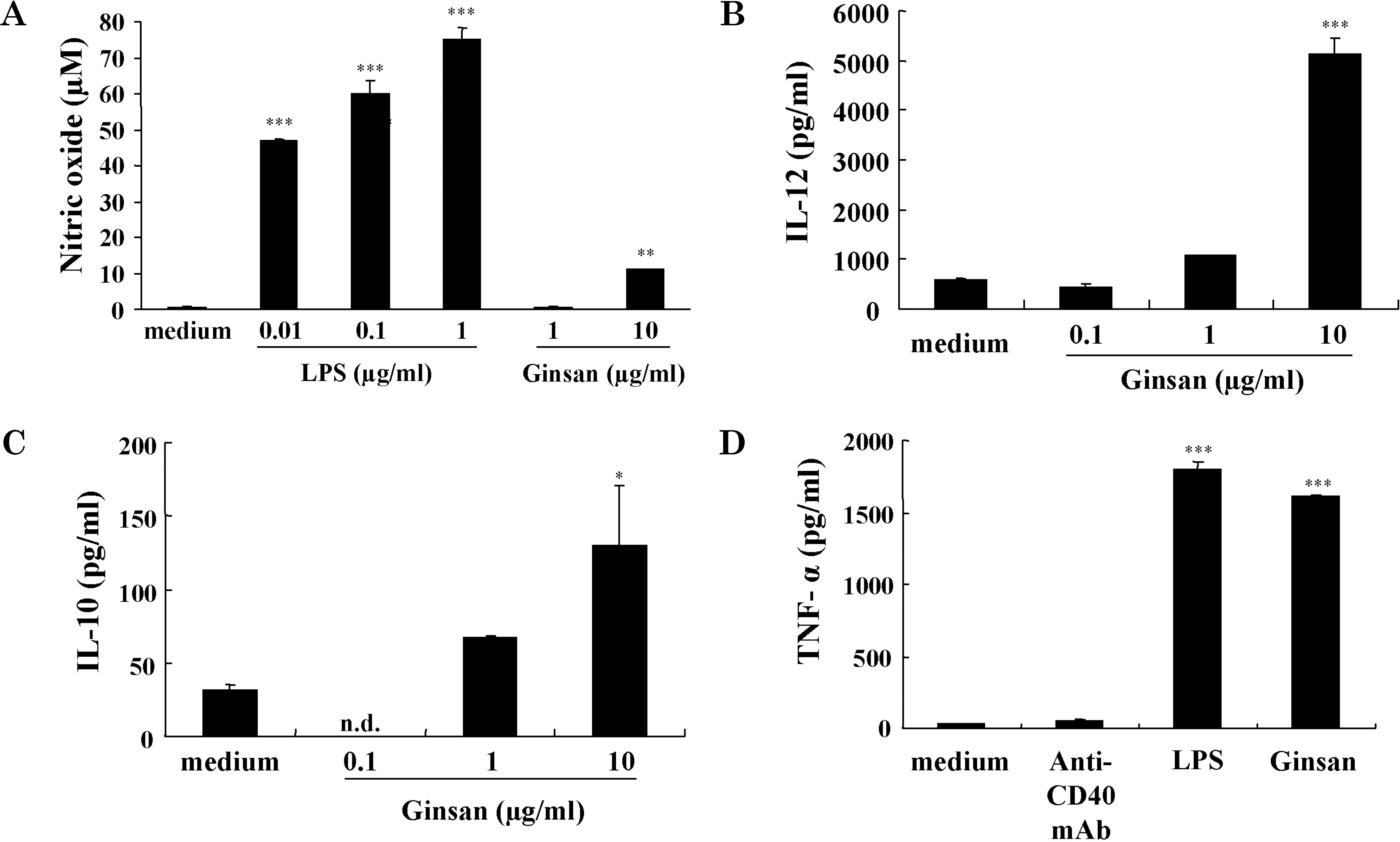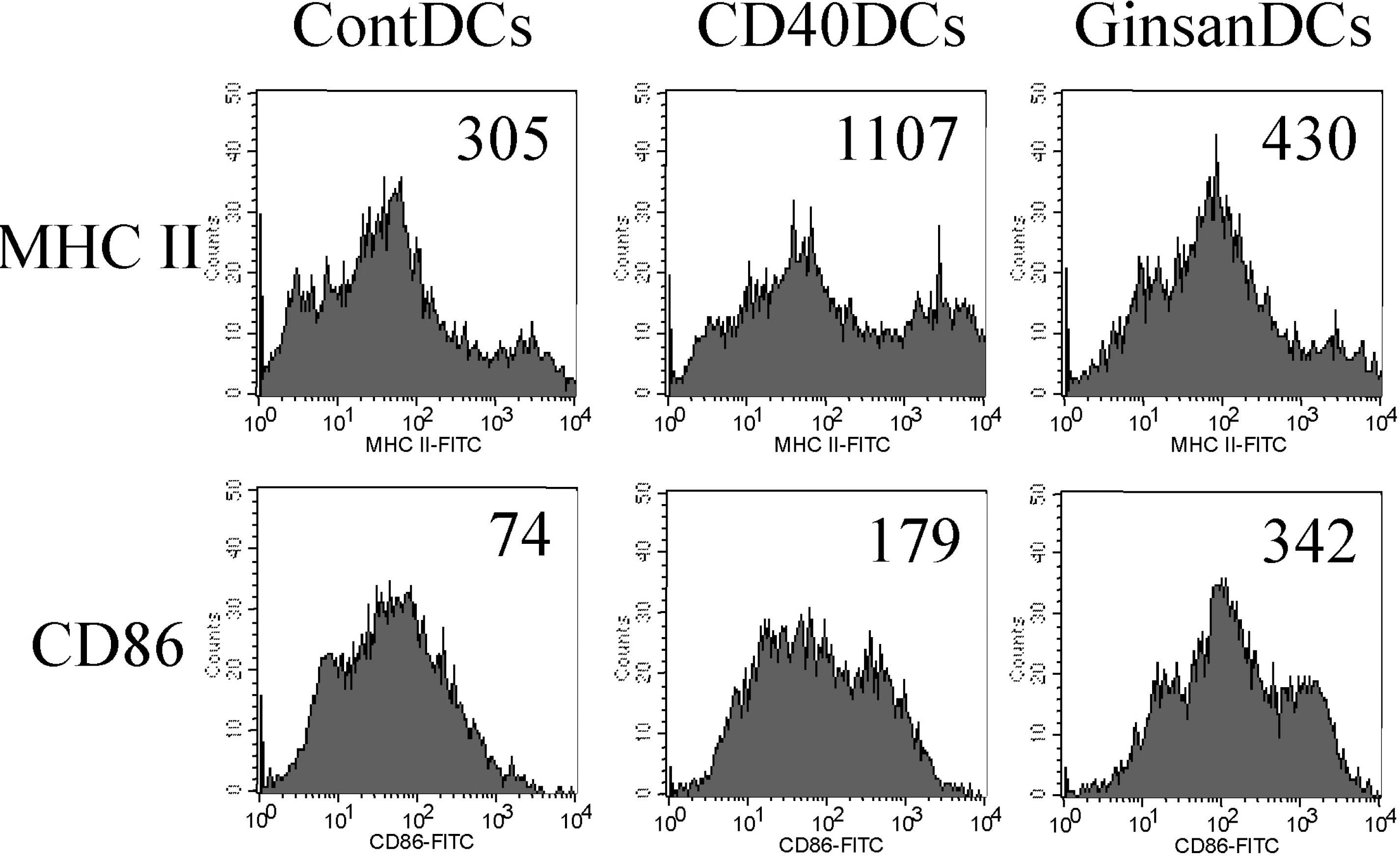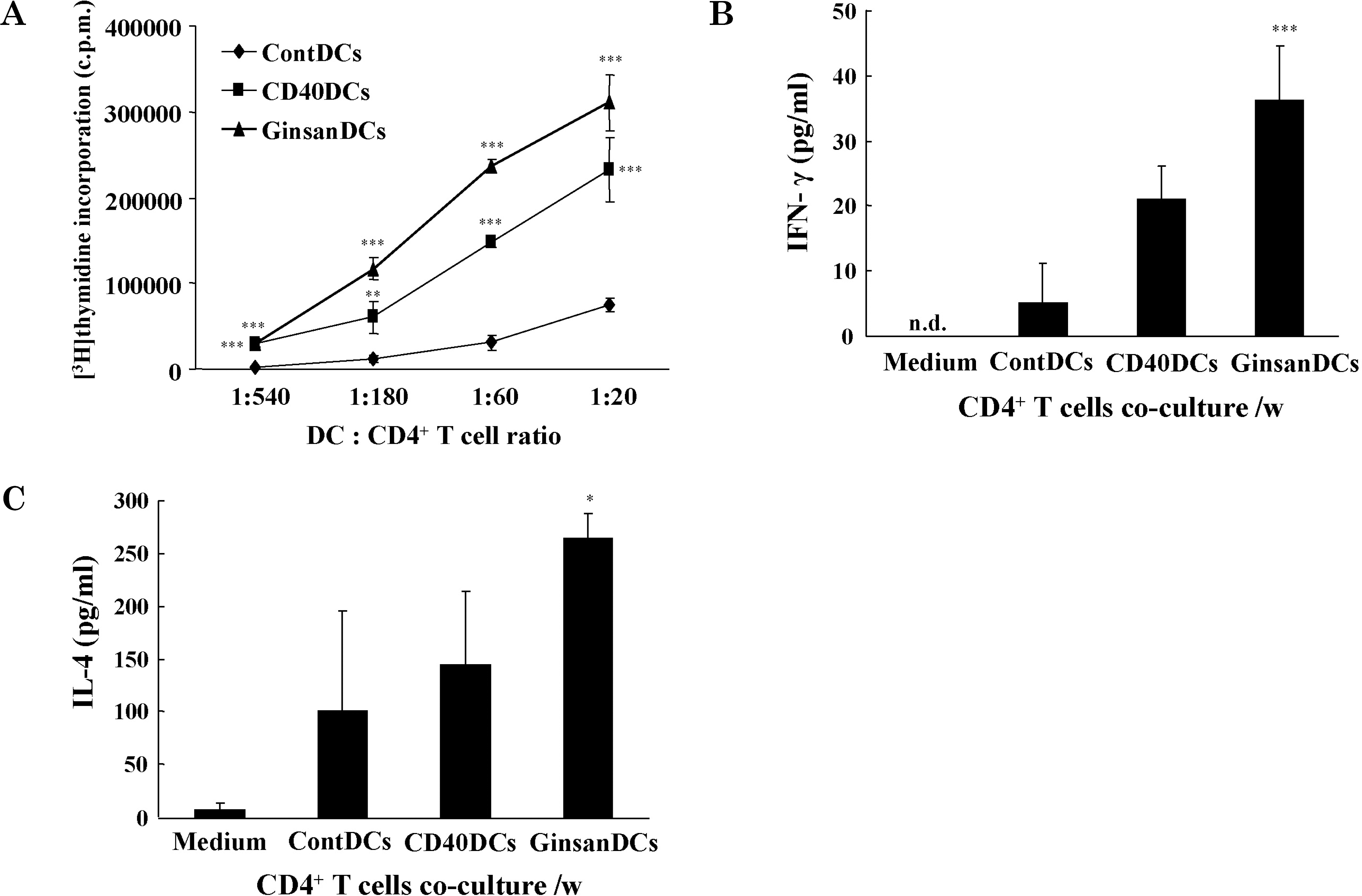Abstract
Ginsan, a Panax ginseng polysaccharide that contains glucopyranoside and fructofuranoside, has immunomodulatory effects. Although several biologic studies of ginsan have been performed, its effects on dendritic cells (DCs), which are antigen-presenting cells of the immune system, have not been studied. We investigated the immunomodulatory effects of ginsan on DCs. Ginsan had little effect on DC viability, even when used at high concentrations. Ginsan markedly increased the levels of production by DCs of IL-12 and TNF-α, as measured by ELISA. To examine the maturation-inducing activity of ginsan, we measured the surface expression levels of the maturation markers MHC class II and CD86 (B7.2) on DCs. It is interesting that ginsan profoundly enhanced the expression of CD86 on DC surfaces, whereas it increased that of MHC class II only marginally. In 3H-thymidine incorporation assays, ginsan-treated DCs stimulated significantly higher proliferation of allogeneic CD4+ T lymphocytes than did medium-treated DCs. Taken together, our data demonstrate that ginsan stimulates DCs by inducing maturation. Because DCs are critical antigen-presenting cells in immune responses, this study provides valuable information on the activities of ginsan.
REFERENCES
Ahn JY., Choi IS., Shim JY., Yun EK., Yun YS., Jeong G., Song JY. The immunomodulator ginsan induces resistance to experimental sepsis by inhibiting Toll-like receptor-mediated inflammatory signals. Eur J Immunol. 36:37–45. 2006.

Bonham CA., Lu L., Li Y., Hoffman RA., Simmons RL., Thomson AW. Nitric oxide production by mouse bone marrow-derived dendritic cells: implications for the regulation of allogeneic T cell responses. Transplantation. 62:1871–1877. 1996.
Corinti S., Albanesi C., la Sala A., Pastore S., Girolomoni G. Regulatory activity of autocrine IL-10 on dendritic cell functions. J Immunol. 166:4312–4318. 2001.

Esche C., Shurin GV., Kirkwood JM., Wang GQ., Rabinowich H., Pirtskhalaishvili G., Shurin MR. Tumor necrosis factor-alpha-promoted expression of Bcl-2 and inhibition of mitochondrial cytochrome c release mediate resistance of mature dendritic cells to melanoma-induced apoptosis. Clin Cancer Res. 7:974s–979s. 2001.
Heufler C., Koch F., Stanzl U., Topar G., Wysocka M., Trinchieri G., Enk A., Steinman RM., Romani N., Schuler G. Interleukin-12 is produced by dendritic cells and mediates T helper 1 development as well as interferon-gamma production by T helper 1 cells. Eur J Immunol. 26:659–668. 1996.
Joo HG. Altered maturation of dendritic cells by taxol, an anti-cancer drug. J Vet Sci. 4:229–234. 2003.

Joo HG., Goedegebuure PS., Sadanaga N., Nagoshi M., von Bernstorff W., Eberlein TJ. Expression and function of galectin-3, a beta-galactoside-binding protein in activated T lymphocytes. J Leukoc Biol. 69:555–564. 2001.
Kim HJ., Kim MH., Byon YY., Park JW., Jee Y., Joo HG. Radioprotective effects of an acidic polysaccharide of Panax ginseng on bone marrow cells. J Vet Sci. 8:39–44. 2007.

Kim MH., Joo HG. Immunostimulatory effects of fucoidan on bone marrow-derived dendritic cells. Immunol Lett. 115:138–143. 2008.

Larsen CP., Ritchie SC., Hendrix R., Linsley PS., Hathcock KS., Hodes RJ., Lowry RP., Pearson TC. Regulation of immunostimulatory function and costimulatory molecule (B7-1 and B7-2) expression on murine dendritic cells. J Immunol. 152:5208–5219. 1994.
Lee YS., Chung IS., Lee IR., Kim KH., Hong WS., Yun YS. Activation of multiple effector pathways of immune system by the antineoplastic immunostimulator acidic polysaccharide ginsan isolated from Panax ginseng. Anticancer Res. 17:323–331. 1997.
Lu L., Bonham CA., Chambers FG., Watkins SC., Hoffman RA., Simmons RL., Thomson AW. Induction of nitric oxide synthase in mouse dendritic cells by IFN-gamma, endotoxin, and interaction with allogeneic T cells: nitric oxide production is associated with dendritic cell apoptosis. J Immunol. 157:3577–3586. 1996.
Mellman I., Steinman RM. Dendritic cells: specialized and regulated antigen processing machines. Cell. 106:255–258. 2001.
Mosca PJ., Hobeika AC., Clay TM., Nair SK., Thomas EK., Morse MA., Lyerly HK. A subset of human monocyte-derived dendritic cells expresses high levels of interleukin-12 in response to combined CD40 ligand and interferon-gamma treatment. Blood. 96:3499–3504. 2000.
Shin JY., Song JY., Yun YS., Yang HO., Rhee DK., Pyo S. Immunostimulating effects of acidic polysaccharides extract of Panax ginseng on macrophage function. Immunopharmacol Immunotoxicol. 24:469–482. 2002.
Song JY., Han SK., Son EH., Pyo SN., Yun YS., Yi SY. Induction of secretory and tumoricidal activities in peritoneal macrophages by ginsan. Int Immunopharmacol. 2:857–865. 2002.

Song JY., Han SK., Bae KG., Lim DS., Son SJ., Jung IS., Yi SY., Yun YS. Radioprotective effects of ginsan, an immunomodulator. Radiat Res. 159:768–774. 2003.

Fig. 1.
Viability of DCs treated with ginsan. DCs were seeded at 5×104 cells/well in 96-well culture plates and treated with different concentrations of ginsan for 2 days. After treatment, an MTT assay was performed, as described in Methods. The representative data, shown as mean±SD, are from three independent experiments that gave similar results. ∗∗p<0.01, ∗∗∗p<0.001.

Fig. 2.
Production of NO and cytokines by DCs treated with ginsan. For the NO assay (A), DCs were established in culture as described in Fig. 1. LPS or ginsan was added to the wells, and the culture supernatants were harvested 2 days later. The NO assay was performed as described in Methods. For cytokine measurements (B~D), DCs were seeded at 5×10 cells/well in 24-well culture plates and treated for 48 h. Concentrations of IL-12 (B), IL-10 (C), and TNF-α (D) in the culture media were measured using ELISA. In D, 1 μg/ml anti-mouse CD40 mAb, 1 μg/ml LPS, and 10 μg/ml ginsan were used. ∗p<0.05, ∗∗p<0.01, ∗∗∗p<0.001.

Fig. 3.
Ginsan increases the expression of maturation markers on the surfaces of DCs. DCs were established in culture and treated as described in Fig. 2B~D. Data shown are representative values from three separate experiments. ContDCs, medium alone- treated DCs; CD40DCs, DCs treated with 1 μg/ml anti-mouse CD40 mAb; GinsanDCs, DCs treated with 10 μg/ml ginsan.

Fig. 4.
Increased antigen-presenting capacities of ginsan-treated DCs. DCs were established in culture as described in Methods. For the MLR assay, DCs were co-cultured with 1×105 cells/well allogeneic CD4+ lymphocytes for 5 days. As described in Methods, the incorporated radioactivity was measured using a scintillation counter. The mean±SD level of radioactivity was derived from five individual wells (A). For the cytokine assay (B, C), 5×103 cells/well DCs were cocultured with 1×105 cells/well allogeneic CD4+ lymphocytes. The culture supernatants were harvested and used to measure IFN-γ (B) and IL-4 (C) levels. Shown are representative data from three independent experiments that gave similar results. ∗p<0.05, ∗∗p<0.01, ∗∗∗p< 0.001.





 PDF
PDF ePub
ePub Citation
Citation Print
Print


 XML Download
XML Download